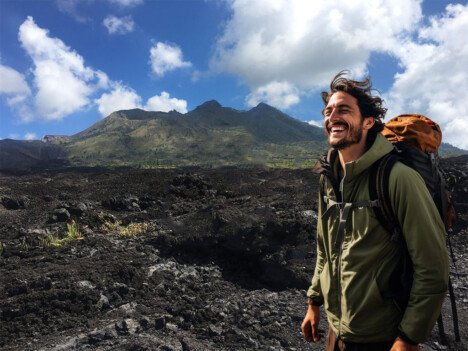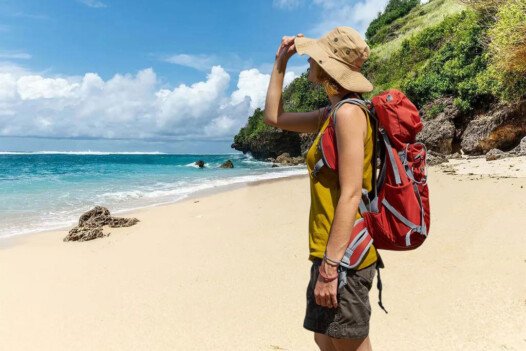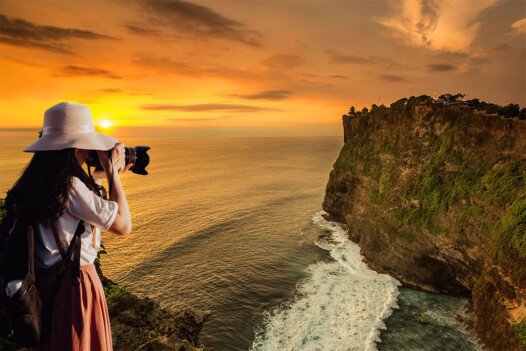Ubud, Bali, is renowned for its lush landscapes, rich culture, and serene atmosphere. Among its most iconic features are the stunning rice terraces that cascade down the hillsides, offering photographers a paradise of natural beauty and cultural heritage. In this comprehensive guide, we’ll explore the best techniques, times, and locations to capture the essence of Ubud’s rice terraces.
📸 Understanding the Beauty of Ubud’s Rice Terraces
Ubud’s rice terraces are more than just picturesque landscapes; they are a testament to Bali’s rich agricultural heritage. The terraces are part of the Subak irrigation system, a UNESCO World Heritage site that dates back to the 9th century. This traditional system not only manages water distribution but also embodies the Balinese philosophy of Tri Hita Karana, which emphasizes harmony between humans, nature, and the divine .
The terraces are typically planted with rice twice a year, during the wet and dry seasons. The wet season, from October to April, brings vibrant green hues to the fields, while the dry season, from May to September, offers golden tones as the rice ripens. Understanding these cycles is crucial for photographers seeking to capture the terraces at their most photogenic.
🕒 Best Times to Photograph the Rice Terraces
Timing is everything in photography, and the rice terraces are no exception. The best times to capture the terraces are:
- Early Morning (6:00 AM – 7:00 AM): The soft, golden light of the morning enhances the textures and colors of the terraces. The air is cooler, and the light is less harsh, providing ideal conditions for photography .
- Late Afternoon (4:00 PM – 5:30 PM): As the sun begins to set, the terraces are bathed in warm, golden hues. The lighting is soft, and the shadows add depth and dimension to your photos.
Avoid midday hours (11:00 AM – 2:00 PM) when the sun is directly overhead, creating harsh shadows and overexposed highlights.
🎒 Essential Photography Gear
To capture the beauty of Ubud’s rice terraces, consider bringing the following equipment:
- Camera: A DSLR or mirrorless camera with manual settings allows for greater control over exposure and depth of field.
- Lenses: A wide-angle lens (16-35mm) is ideal for sweeping landscape shots, while a telephoto lens (70-200mm) can help capture distant details and compress the scene.
- Tripod: Essential for stability, especially during low-light conditions like early morning or late afternoon.
- Filters: A polarizing filter can reduce glare and enhance the colors of the sky and foliage.
- Drone: For aerial shots that showcase the intricate patterns of the terraces from above.
📍 Top Locations for Photography
While the entire region of Ubud offers stunning rice terraces, certain locations stand out for their accessibility and photographic potential:
- Tegallalang Rice Terrace: Perhaps the most famous, Tegallalang offers expansive views and is easily accessible from central Ubud. Arrive early to avoid crowds and capture the terraces in the soft morning light .
- Jatiluwih Rice Terrace: A UNESCO World Heritage site, Jatiluwih offers expansive, less-crowded terraces. The panoramic views are perfect for wide-angle shots and drone photography.
- Aloha Ubud: Located near Tegallalang, Aloha Ubud offers a more intimate experience with swings and nests set amidst the terraces, adding unique elements to your photos .
- Campuhan Ridge Walk: While not a rice terrace, this scenic walk offers sweeping views of Ubud’s valleys and rice fields, providing a different perspective for your photography.
📷 Photography Tips and Techniques
To make the most of your photography sessions, consider the following tips:
- Use Leading Lines: The terraces’ rows of rice plants create natural lines that lead the viewer’s eye through the image.
- Incorporate Local Life: Including farmers at work or traditional Balinese structures can add a human element to your photos and tell a story.
- Experiment with Angles: Shoot from different heights and perspectives to find the most compelling compositions.
- Golden Hour Lighting: Utilize the soft, warm light during early morning and late afternoon to enhance the textures and colors of the terraces.
- Respect Local Etiquette: Always ask for permission before photographing local farmers or their property, and be mindful of your surroundings to avoid disrupting their work.
🌿 Cultural Etiquette and Respect
When photographing Ubud’s rice terraces, it’s essential to respect local customs and traditions:
- Ask for Permission: Always seek consent before photographing local farmers or their property.
- Stay on Designated Paths: Avoid walking through the rice fields to prevent damage to crops and respect the farmers’ hard work.
- Support the Community: Consider making a small donation or purchasing local products as a gesture of appreciation for the community’s hospitality.
🧭 Additional Tips for an Enjoyable Photography Experience
- Wear Appropriate Footwear: The terrain can be uneven and slippery, especially during the rainy season. Sturdy, comfortable shoes are recommended.
- Stay Hydrated: Bali’s tropical climate can be hot and humid. Carry water to stay hydrated during your photography sessions.
- Plan Your Visit: Research the best times to visit each location to avoid crowds and ensure optimal lighting conditions.
- Embrace the Experience: While capturing beautiful images is the goal, take time to immerse yourself in the serene beauty of Ubud’s rice terraces and appreciate the cultural significance they hold.
🏁 Conclusion
Photographing Ubud’s stunning rice terraces offers an opportunity to capture the natural beauty and cultural heritage of Bali. By understanding the best times to visit, equipping yourself with the right gear, and respecting local customs, you can create compelling images that showcase the essence of this enchanting destination.
❓ FAQ – How to Photograph Ubud Bali’s Stunning Rice Terraces
1. What is the best time of year to photograph Ubud’s rice terraces?
The best time to photograph the rice terraces is during the wet season (October to April) when the fields are lush and green, or just before harvest (around June or September) when the terraces turn golden. Each season offers a unique aesthetic for photographers.
2. When is the best time of day for taking photos?
Early morning (around 6:00–7:00 AM) and late afternoon (4:00–5:30 PM) are ideal due to the soft, golden lighting. These times also help avoid harsh shadows and strong overhead sunlight common at midday.
3. Do I need a professional camera to photograph the rice terraces?
No. While a DSLR or mirrorless camera provides the most control, modern smartphones with high-quality cameras can also capture stunning photos, especially when combined with good lighting and composition techniques.
4. Are drones allowed at the rice terraces?
Drones are generally allowed in most areas like Tegallalang and Jatiluwih, but you should always check local regulations and fly responsibly—avoid flying over people, temples, or private property without permission.
5. Is there an entrance fee to the rice terraces?
Some terraces, like Tegallalang, may charge a small entrance or donation fee to maintain the area. Others, like Jatiluwih, have a ticketed entrance as part of their status as a UNESCO World Heritage site.
6. Can I hire a local guide or photography tour in Ubud?
Yes, many tour companies offer photography-focused tours that take you to the best viewpoints at optimal times. Hiring a guide can provide local insights and access to less touristy spots.
7. Is it safe to walk around the rice terraces with camera gear?
Generally, yes. The paths can be uneven or muddy, especially after rain, so wear sturdy shoes and be mindful of where you step. Keep gear secured and avoid carrying too much to maintain mobility.
8. Can I photograph farmers working in the rice fields?
Yes, but always be respectful and ask for permission first. Many locals are friendly and open to being photographed if approached politely.
9. What editing style works best for rice terrace photos?
Enhancing greens, contrast, and clarity often works well. Using tools like Lightroom or Snapseed can help bring out the texture and depth of your shots without over-processing.
10. Do I need a filter or lens accessory?
A polarizing filter is highly recommended to cut glare and enhance color contrast, especially when shooting under strong sunlight. ND (Neutral Density) filters can also help with long exposures.









